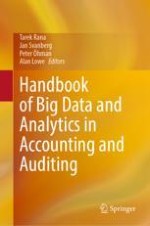2023 | OriginalPaper | Chapter
12. Integrating ESG Risks into Control and Reporting: Evidence from Practice in Sweden
Authors : Jason Crawford, Fredrik Nilsson
Published in: Handbook of Big Data and Analytics in Accounting and Auditing
Publisher: Springer Nature Singapore
Activate our intelligent search to find suitable subject content or patents.
Select sections of text to find matching patents with Artificial Intelligence. powered by
Select sections of text to find additional relevant content using AI-assisted search. powered by
